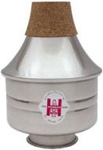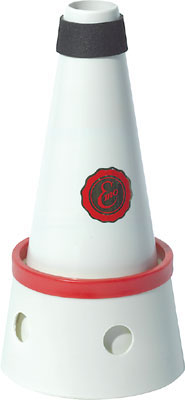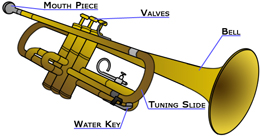Contents:
General information about brass:
In the orchestra the brass section is split up into four segments; Horns in F (I-IV), Trumpets (I-III), Trombones (I & II, Bass) and Tuba. The brass section is also one of the sections that contain 'transposing instruments' (Transposing: horns and trumpets).
#1: Trumpet layout (click to enlarge)
Image #1 shows an example of how an instrument may be laid out in the brass section. This example is of the trumpet, although all the brass instruments look different to one another, they all share similar design features.
Tone
Brass players use their lips to create vibrations down the mouth piece to produce the sound out of the bell. The lips loosen for lower notes and tighten for higher notes; this is known as ‘embouchure’. The tone is also dependent on the shape of mouth piece used in the instrument. A trumpet uses a shallow cupped mouth piece giving it much brighter tone than the horn, which uses a funnel-shaped mouth piece. The same is true for the trombone and tuba with the tuba having the deepest cupped mouth piece, therefore having a duller tone. Back to top
Breathing
It should be remembered that playing a brass instrument requires quite a bit of wind (more so than the woodwind) and therefore can be quite tiring for the player, so be sure to allow for regular rest points in the music. Don’t write too many notes under a slurred phrase, especially when the tempo is slow, as these phrases will be played with one breath. (see also ‘Breathing’ on the woodwind page)
Circular Breathing
This is a technique that can be used to make it appear that the player doesn’t need to take a breath. As they are playing they lock off the air in their mouths so they can carry on producing sounds, while taking in air through their nose, back up from their lungs into the mouth. Although this is possible to do in all wind instruments to some degree, it is not a common practice. If this is what’s required in the music however, discuss it with the performer. Back to top
Tonguing
This process gives the note its attack; many varieties of tonguing are available from brass players.
Soft Tonguing
The player doesn’t apply so much attack with the tongue, using a ‘da’ or a ‘doo’, making the tone softer and more lyrical.
Double-Tonguing
A technique used for playing a succession of notes in duple time, possibly at some speed. An example of the tonguing action is ‘Tu ka’, which is the way in which the tongue must move to perform this technique.
Triple-Tonguing
Another tonguing technique, this time used for playing a succession of notes in triple time, possibly at some speed. An example of the tonguing action is ‘Tu Tu ka’, similar to double-tonguing technique but produces a triplet effect.

#2: Slur Markings
Slurring
No tonguing is used at all. To notate simply draw a slur marking over the notes where a slur is required, e.g. image #2. If the phrase is not slurred, then each not will be tongued, meaning every note with have some articulation to it. Back to top
Trills & Tremolos

#3: Trill & tremolo notation
Trills and tremolos can be performed on brass instruments, although it is different each instrument, so it will be discussed in greater detail on each page. Trills are possible on all brass instruments and most can perform some tremolos with success. To notate a trill, simply write a ‘tr’ above the note with a curving line afterwards. To notate a tremolo, write with three lines through the stem of the note or above / below it if there is no stem. Back to top
Mutes
As the name suggests these add-ons mute the sound of brass instruments and can create many different sounds and effects. There are many different types, shapes and sizes of mute depending on the instrument they are used on. When writing for mutes, remember to leave sufficient time in the music for the performer to pick up and position the mute before asking them to play (the bigger the mute and instrument, the more time is needed), as well as time for removing it again.
To notate for a mute simple write ‘mute’ or ‘muted’ or the Italian ‘con sordino’ (short: ‘con sord.’) above the start section and ‘open’ at the start of the next section that doesn’t require a mute. If a specific mute is required then replace ‘mute’ or ‘muted’ with the name of the mute wanted to play the section, otherwise the performers will automatically use a ‘straight’ mute or their equivalent. The following are examples of the most common mutes.






#4: Most common mutes
Straight Mute
This mute is the standard mute used by trumpeters and trombonists. It can create a sound that cuts through a texture when played at fortissimo and also give the impression of distance to the instrument.
Cup Mute
In general this mute produces nasally and washed-out tones but the cup on the mute can be adjusted to suit the sound needed for the piece. The closer the cup is to the bell the darker and more muffled the sound gets.
Wa-Wa or Harmon Mute
Given it’s name because of the ‘Wa-Wa’ sound it can produce when the perform opens and closes his hand over the whole at the end of it. To notate the open and closed effect simply write a " " for closed and a "
" for closed and a " " to open again above each note.
" to open again above each note.
On it’s own with the ‘stem’ all the way in it gives a piercing, sparkling tone; this is duller when used on the trombone. The ‘stem’ can be moved in and out of the mute to create variations in the tone. By removing the ‘stem’ completely from the mute it creates a new tone that sounds dark and distant and is much quieter.
Whispa Mute
As the name suggest it’s very quiet, and makes the instrument sound very distant. So if it is played very softly it can be impossible to hear.
Solotone Mute
Gives a nasally tone similar to that of a telephone or old radio. Back to top
